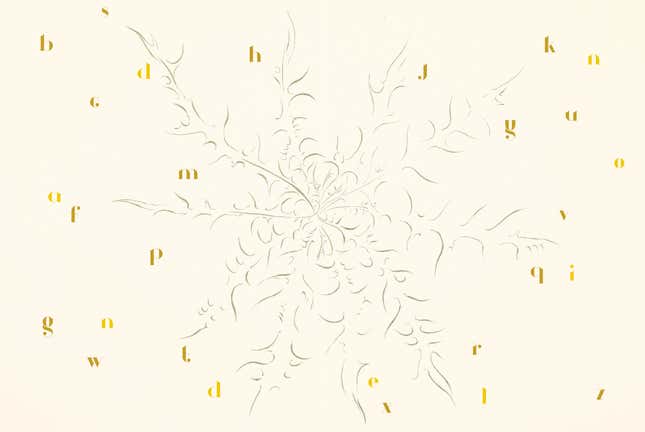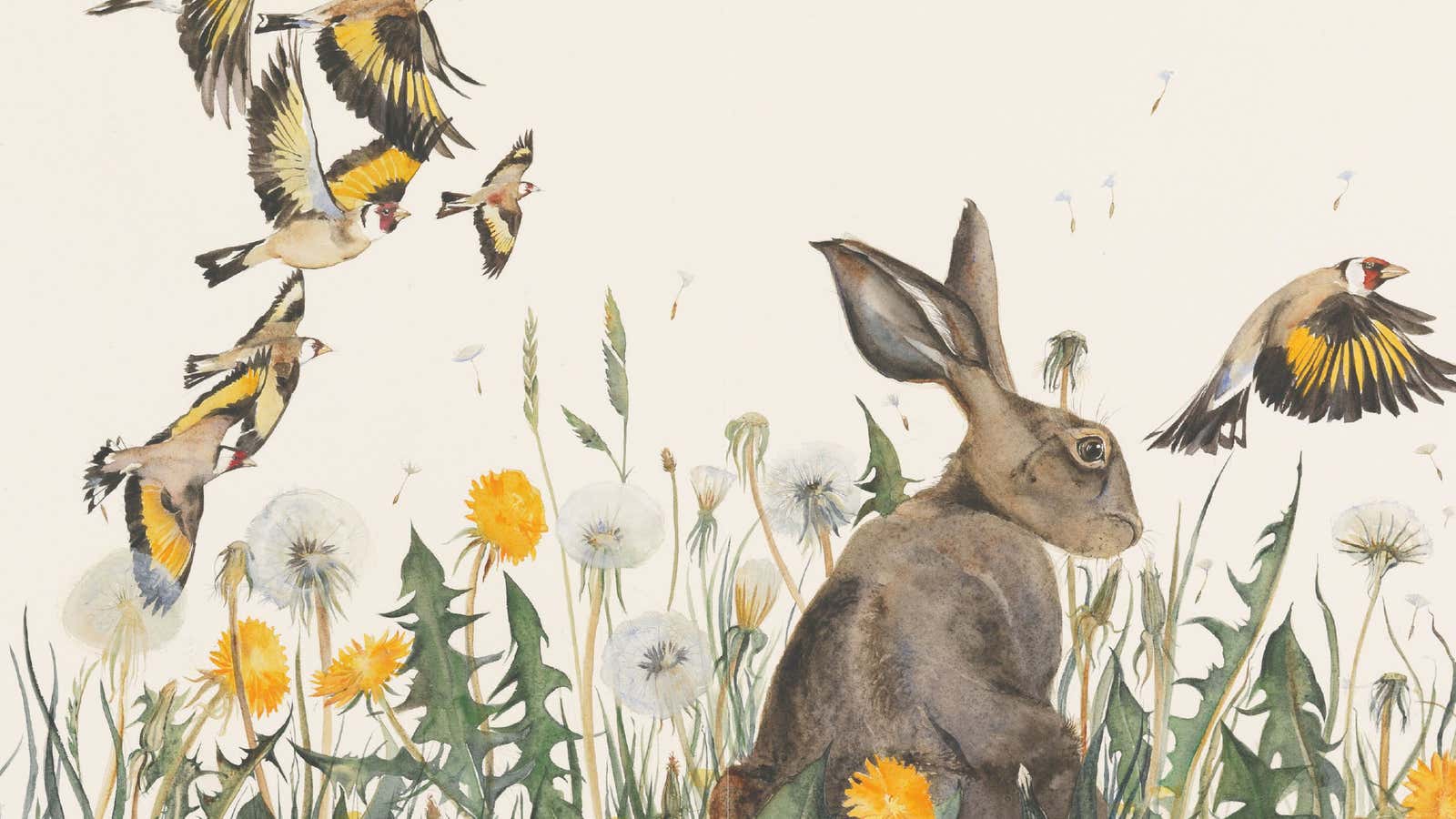“Once upon a time, words began to vanish from the language of children. They disappeared so quietly that at first almost no one noticed—fading away like water on a stone.”
So begins The Lost Words (House of Anansi), a book of lyrical writing by British author Robert Macfarlane, with lush illustrations by artist Jackie Morris.
Since it was published a year ago in the UK, the book has become a bonafide “cultural phenomenon,” inspiring grassroots campaigns to put the book—an ode to nature—in thousands of primary schools; musical and spoken word interpretations; and both a short and (forthcoming) feature film. In short, it has become a movement—and this fall, the book finally arrived in the US and Canada.
Part of its enchanting and galvanizing power can be traced to its origin story, a real event alluded to in the title and in the opening lines. In 2007, Oxford’s “Junior” dictionary, for children age seven and above, tossed out several words from the natural world. Words like “moss,” “blackberry,” and “bluebell” were erased from Oxford’s dictionary for children in order to make room for technological terms like “blog,” “chatroom,” and “database.”
Then, in 2015, a group of 28 writers penned an open letter to the publisher. Why, they wanted to know, should children have to choose between the hard-edged language of the internet and the name of a flowering plant? Why was the word “voicemail” more important than “wren?” “In light of what is known about the benefits of natural play and connection to nature; and the dangers of their lack, we think the choice of words to be omitted shocking and poorly considered,” the authors declared.
Macfarlane and Morris were among the people who’d signed the letter. It seeded the creation of the The Lost Words—an exquisite example of turning to one’s craft to devise subtle, inventive protest. Its success is a welcome reminder that art, as well as nature, can still cast a spell over all of us—adults and children alike.
Not a book, but a landscape
The Lost Words is not an average book in any sense, including in its size; it’s a foot and a half high. Macfarlane often refers to it as a landscape that children try to physically enter.
Its basic storytelling structure is both simple and ingenious. “It’s just 20 ‘lost’ words,” the author told the Canadian Broadcasting Corporation (CBC.) “It begins with acorn. It ends with wren. And it makes a crooked, almost A-to-Z through heron and kingfisher and bluebell and otter all the way to the end.”
For each word, he and Morris wanted to create a “summoning back—a magical procession,” Macfarlane explains. “So you open the first page for acorn, and nothing is there. Acorn is gone. All that the acorn leads to is gone. The oak tree is gone. The forest is gone. There’s just a page of almost absence.”

But there is a beautiful mess of letters, a few of which are highlighted in color. They spell out the word of whatever is being conjured, “acorn” in this case.
With that puzzle solved, “you turn the page, and there is acorn, back on gold leaf—a wonderful acorn icon painted by Jackie. And there is a full spell written by me,” Macfarlane said, “to be read aloud by the children, by their parents, anyone.”
Once the spell, which is acrostic, is read aloud, the child or adult turns the page again, this time to find a detailed watercolor painting across a two-page spread. The acorn, wren, or otter is back, and in context. The landscape has returned, and, apparently, your naming exercise and spoken spell has made that happen.
Read a sample, his “Otter Summoning Spell,” by clicking into the page from the book here:
In a powerful essay about The Lost Words published in the Guardian, Macfarlane called the dictionary flap “a moment in lexicographic analysis which spoke of a much bigger moment in culture, where childhood is becoming virtualized, interiorized — and nature is slipping from childhood, as it is slipping from all our lives.”
As we’re confronted with a slow drip of disturbing news about “the insect apocalypse,” dying forests, and accelerated patterns of extinction, his book is one of many signs of human attempts to salvage our relationship with the traumatized natural world.
Arguably, the same yearning is evident in the millennial fascination with houseplants, or “urban wilding,” as the trend has been dubbed. And in wellness trends, like the Japanese practice of forest bathing—literally spending time within a forest, to boost your mood and immune system. We’re looking to reconnect— and to reestablish a relationship between children and the wild that was once a given.
The power of naming
Macfarlane’s spells aim to “weave a gauze of sound” around his readers, as he wrote in The Guardian, paraphrasing poet Seamus Heaney. He also recalls in interviews how they would occur to him at random times and places—while standing in line at the grocery store, for instance. He would compose and revise, and eventually send the verses to Morris, who would read the lines into the wind near her home on the coast of Wales. She would let him know when they needed tweaks, and when they were perfect just as they were. Of course, he also auditioned the spells with his children.
Macfarlane’s method of engaging the senses through sight and sound is strategic: he wants to create experiences we remember as clearly as Proust did his madeleine. We can’t protect something we’ve forgotten about, he argues. Like ancient “binding spells” of Egypt and Greece, which sometimes took on palindromic or other riddle-like forms, these texts are linked to a specific desire, to defend the earth’s dwindling diversity by helping us see and marvel at what’s left first.
Speaking aloud is another way to leave a lasting mark on the mind. “When we say things, that is where literature begins. And to put them back in the mouth is to put them back in the mind’s eye,” Macfarlane told the CBC. “Magic works with speaking aloud, and so we wanted to catch a little of that.”
To simply “identify” nature within a taxonomy, as one would in school, implies a hierarchy of power or importance, he has proposed. By contrast, he explained in the Guardian, “[t]he right names, well used, can act as portals – ‘hollowings” in Robert Holdstock’s term – into the more-than-human world of bird, animal, tree and insect. Good names open on to mystery, grow knowledge and summon wonder.”
Language, rewilded
Recently, Macfarlane, who studied English literature at Cambridge University, has turned his Twitter account into a public service, educating his followers daily about the names of birds and animals, and phenomena in forests or the skies, word by word. It’s as if he’s setting suppressed memories free.
Some of his Twitter offerings are tagged “#LexiconForTheAnthropocene,” referring to the current geological age, one defined by the dire effects of human dominance and short-sightedness.
Others wake us up to quotidian scenes and organisms that have not received their due attention, or that we’ve snapped a photo of for Instagram, but understand only superficially.
Visiting classrooms, Macfarlane has discovered that many children can not identify an acorn or a kingfisher, he told the Canadian Press. But as Macfarlane’s 125,000-strong Twitter following demonstrates, people are deeply curious about the natural environment. Likewise, The Lost Words, which has won several awards, including Children’s Book of the Year 2018 from the British Book Awards, has tapped into a latent craving for more knowledge about non-human life around us. In the UK, school children have created “Lost Words” galleries, accompanied by student-written spells.
Ultimately, The Lost Words will hopefully spur people of all ages to spend more time directly engaged with and observing nature, for the multitude of benefits it offers. Some cognitive scientists believe that when we’re tromping around in nature, or climbing trees, or canoeing, the combination of being away from technology, exercising, and simply being in a green space improves creativity. For children, time spent outdoors is an opportunity to get to know themselves, as naturalist and TV producer Stephen Moss once told the Guardian. It’s not only healthier for the body, it’s a chance to solve problems, build self-confidence, develop social skills, and allow a range of life forms and colors to expand the mind.
Indeed, some artists worry that the loss of species that we’re experiencing, and our increasingly urban-centric life may also lead to less human innovation, since the colors, shapes, and systems of life have inspired books, paintings, and music for hundreds of years.
The Lost Words has also arrived just as the medical world is finally taking seriously nature’s stress-relieving effects. Convinced by hard science, doctors in Europe, parts of Asia, the UK, and the US are prescribing hikes and gardening to patients recovering from illnesses, or struggling with their mental health, and newer hospital designs are beginning to give patients more connections, through sight or sound, to the natural world.
Recently, The Lost Words illustrations were reproduced for a hospital in a London suburb, where they brought a vibrant country meadow to a otherwise plain, dull hallway. The Royal Botanic Garden in Edinburgh has introduced The Lost Words to dementia patients who visit the garden for special programs, and Macfarlane has received videos of both dementia patients and others with cognitive impairments, reading the book aloud.
And last month, a crowd-funded effort raised enough money to put a copy of The Lost Words in every hospice in the UK, where medical staff have recognized the soothing effect that nature can have on anxious patients facing the end of life.
As a palliative care doctor in the UK recently illustrated in a New York Times editorial, merely having a view onto a garden, and to be near enough to blackbirds to hear their birdsongs, seems to offer the dying the sense of belonging to something larger than their own life, something perhaps sacred and eternal. The Lost Words, with its imagery and verse, is thought to have the power to elicit this same feeling, one also captured in scores of poems, whether by the nature-adoring poet Mary Oliver or Emily Dickinson, whose poem “If I should die” includes: “’T’is sweet to know that stocks will stand/When we with daisies lie.”
Though the international edition was only released in North America in October, the Lost Words effect, so to speak, has already manifested in at least one bookstore’s pledge to donate part of its sales proceeds to an educational nature program on Vancouver Island. It’s probably safe to expect many more such community-based projects.
Handily, Macfarlane recently tweeted the perfect descriptor for his and Morris’ creation: “quaquaversal,” literally “wherever-towards” or a radiance that’s “dipping or emanating in all directions from a central point.”
It began as a geological term, he wrote, but it can now be applied to a person, an idea, or a work of art.




